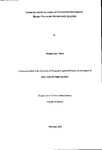SOURCES AND STRUCTURES OF COMMONLY OCCURRING HIGHLY BRANCHED ISOPRENOID ALKENES
| dc.contributor.author | Allard, William Guy | |
| dc.contributor.other | Faculty of Science and Engineering | en_US |
| dc.date.accessioned | 2013-10-14T09:40:53Z | |
| dc.date.available | 2013-10-14T09:40:53Z | |
| dc.date.issued | 2002 | |
| dc.identifier | NOT AVAILABLE | en_US |
| dc.identifier.uri | http://hdl.handle.net/10026.1/2197 | |
| dc.description.abstract |
Highly branched isoprenoid (HBI) alkenes are ubiquitous lipids which have been identified in numerous geochemical samples, ranging from recent sediments to ancient oils. At the outset of the current investigation, the diatomaceous algae Haslea ostrearia (C25 alkenes) and Rhizosolenia setigera (C25 or C30 alkenes) were the only reported biological sources of these compounds. However, there remained a poor correlation between isomers found in diatoms and those commonly reported in sediments and water column particles. In the present study, the structures of fourteen novel C25 HBI trienes, tetraenes and pentaenes, and four C30 HBI pentaenes and hexaenes have been rigorously characterised via gas chromatography-mass spectrometry (GC-MS) and nuclear magnetic resonance (NMR) spectroscopy following isolation from diatoms. The GC-MS characteristics of the four novel C30 HBIs and eight of the novel C25 HBIs characterised herein show an excellent correlation with those of the HBIs commonly reported in sediments and water column particles. In contrast to the HBIs characterised previously, which all possess a saturated branch point and fixed double bond stereochemistry, the common isomers (C25 and C30) possess an unsaturated branch point and exhibit E/Z isomerism about a trisubstituted double bond. Three diatoms belonging to the Pleurosigma genus have been identified as HBI producers. Of these, the benthic species P. intermedium and the planktonic species Pleurosigma sp. have been found to biosynthesise the common C25 HBI isomers. P. planktonicum has also been identified as a producer of C25 HBIs possessing a novel structural type. The HBI distributions in five distinct strains of R. setigera have been investigated, and these were found to be highly variable. Two strains isolated from the northwest Atlantic were found to produce a single, uncommon C25 HBI pentaene, which has also been reported in H. ostrearia. In contrast, R. setigera isolated from the Arabian Sea was found to produce C30 HBIs only, whilst two strains isolated from southern Brittany were found to co-produce the common C25 and C30 HBI isomers. Four diatom species belonging to the Haslea genus have also been newly identified as producers of C25 HBI alkenes. The HBI distributions in H. salstonica, H. crucigera, H. pseudostrearia and Haslea sp. were examined, and HBI production appears to be widespread within the Haslea genus. All of the HBIs identified in these Haslea spp. were of the structural type previously observed in H. ostrearia, and thus do not correspond to the HBI isomers most commonly reported in sediments and particles. Hydrocarbon extracts isolated from sediments and particulates from the Arabian Sea, Cariaco Trench, Peru upwelling region and the Black Sea were examined by GC-MS, and the HBI isomers in these samples were identified | en_US |
| dc.language.iso | en | en_US |
| dc.publisher | University of Plymouth | en_US |
| dc.title | SOURCES AND STRUCTURES OF COMMONLY OCCURRING HIGHLY BRANCHED ISOPRENOID ALKENES | en_US |
| dc.type | Thesis | |
| dc.identifier.doi | http://dx.doi.org/10.24382/4002 |
Files in this item
This item appears in the following Collection(s)
-
01 Research Theses Main Collection
Research Theses Main


